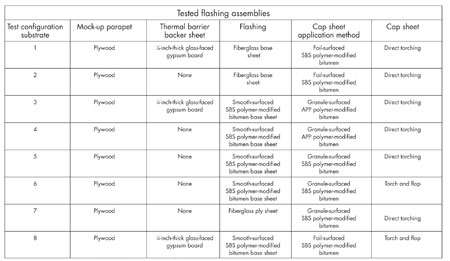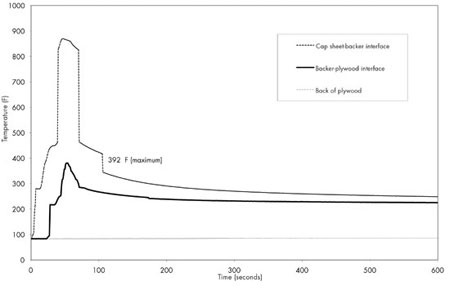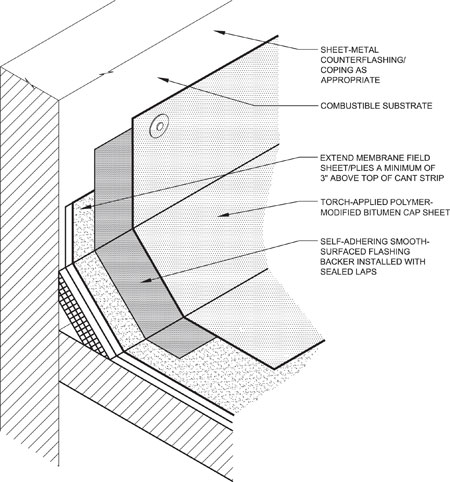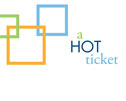Ray Bradbury's classic novel Fahrenheit 451 is a commentary about free speech and censorship. In the novel, 451 F is identified as the temperature at which books—or paper—will ignite and censorship of the written word will be achieved.
Although not about roofing, the novel introduces a fundamental concept that can be applied to the fire safety of torch-applied polymer-modified bitumen roof systems. For example, if during the application process the ignition temperatures of combustible substrate materials are not reached, the likelihood of fire is greatly diminished.
To test this concept as it applies to torch-applied polymer-modified bitumen roofing products, NRCA and Hughes Associates Inc., Baltimore, a nationally recognized fire consulting firm, devised a program to test whether commonly encountered combustible substrates will likely ignite during torching; the test revealed the minimum ignition temperature of such substrates is 570 F.
Test program
The test program consisted of torch applying polymer-modified bitumen membrane base flashing system configurations over an instrumented substrate. The temperature measurements obtained from the instrumentation then were compared with known ignition temperatures for combustible materials commonly used as roof substrates.
For the purpose of testing, a wood-framed parapet wall mock-up was constructed and covered with 5/8-inch-thick construction-grade plywood sheathing. The mock-up was constructed so the plywood sheathing's backside was exposed to ambient conditions and accessible to instrumentation setup. Thermocouples were installed on the front side (roof side) and backside of the mock-up's plywood sheathing to measure the plywood's surface temperatures during torching.
Eight membrane flashing configurations were evaluated in the program. Three test configurations included a 1/4-inch-thick layer of glass-faced gypsum board directly over the plywood sheathing substrate underneath the membrane base flashing layers. Three flashing backer sheet types (fiberglass ply sheet, fiberglass base sheet and smooth-surfaced SBS polymer-modified bitumen base sheet) and three cap sheet types (granule-surfaced APP polymer-modified bitumen, granule-surfaced SBS polymer-modified bitumen and foil-surfaced SBS polymer-modified bitumen) were evaluated.

Figure 1: Components and application methods for test configurations
For each base flashing configuration, flashing backers were nailed to the substrate. The polymer-modified bitumen cap sheets were installed using a 400,000-Btu handheld field torch. Six flashing configurations tested were installed using the direct torching method, and two were installed using the torch-and-flop installation technique.
The specific flashing assemblies tested are identified in Figure 1.
In addition to the thermocouples placed on the front and back of the plywood sheathing, thermocouples were embedded between the flashing layers, allowing for the measurement of temperatures and heat transfer through the flashing layers during torch application. The thermocouples were connected to a multichannel data logger that collected temperature measurements at a rate of 10 Hz during a 10-minute period for each membrane flashing configuration tested.
Results
For each membrane flashing configuration tested, a time-temperature profile graph was developed from thermocouple data that depicts temperatures recorded at the components' surfaces. A representative time-temperature profile graph is shown in Figure 2.
Review of the time-temperature profile graph for each membrane flashing configuration reveals the maximum temperatures at the interface of the flashing backers and cap sheets ranged from 572 to 932 F. This relatively wide range of recorded temperatures is attributable to the different amounts of heat necessary to bond the different cap sheets to the flashing backers.

Figure 2: A representative time-temperature profile graph developed from thermocouple data during torching
The maximum temperature achieved at the interface of the flashing backer sheet to the substrate (plywood or 1/4-inch-thick glass-faced gypsum board) was 392 F. This value was nearly consistent for each flashing configuration tested.
In each test, the temperatures at the backside of the plywood flashing substrate were found to remain at the ambient temperature throughout the test.
Maximum measured temperatures were found to be maintained for short time periods coinciding with the torch flame being in the direct vicinity of the thermocouple measuring the temperature. If the torch flame was moved away from the specific thermocouple location by as little as several inches, the measured temperatures quickly decreased.
The cooling rates of the foil-surfaced membrane and granule-surfaced SBS polymer-modified bitumen membrane cap sheets were found to be more gradual than those using APP polymer-modified bitumen cap sheets. Also, the cooling rate of the 1/4-inch-thick glass-faced gypsum board was noticeably more gradual than the configurations without the gypsum board layer.
Analysis
Finding a maximum temperature of 392 F between the flashing backer sheet and substrate is significant because this is also the temperature that could occur at the surface of combustible substrate materials. This value then can be compared with the ignition temperatures of commonly used combustible construction materials.
Based on review of published literature sources, the piloted ignition of wood generally occurs in the temperature range of 660 to 690 F for softwoods and 570 to 590 F for hardwoods. Autoignition temperatures are in the range of 950 to 1,022 F. It also is reported that wood sheathing's ignition temperatures are similar to those of solid wood of the same species.
Comparing these ignition temperatures to the 392 F maximum achieved during our testing shows torching temperatures of the membrane flashing configurations tested are 178 to 298 degrees lower than the piloted ignition temperatures and 558 to 630 degrees lower than the autoignition temperatures of combustible wood substrate materials commonly encountered in roofing.
In situations where a flame or other ignition source can directly contact combustible substrates, the piloted ignition values apply. In situations where elevated temperature—but not direct flame contact—can reach a combustible substrate, the autoignition temperature values generally apply and provide a greater margin of safety.
Therefore, when roofing workers torch apply polymer-modified bitumen sheet products as membrane base flashings over combustible substrates, the flashing backer is a critical element because it separates a torch's open flame from a combustible material. In situations where an air-impermeable flashing backer is used that will prevent the passage of flame to the combustible substrate, an even greater safety margin is achieved.
Revising guidelines
Based on this testing's favorable findings, NRCA is revising its guidelines for torch-applied membrane flashings using polymer-modified bitumen sheet products. NRCA's new guidelines will allow the use of direct torching over combustible substrates with specific stipulations.
Specifically, NRCA will recommend the use of direct torching of polymer-modified bitumen sheet product membrane flashings over plywood, oriented strand board, wood board or wood plank, and wood fiberboard flashing substrates using a single-burner, low-output (105,000 Btu or less) detail torch and where the substrate has been covered with an air-impermeable flashing backer with sealed laps.

Figure 3: NRCA's new recommended configuration for torch-applied membrane flashings
Examples of such air-impermeable flashing backers include a layer of fiberglass ply sheet, fiberglass base sheet or polymer-modified bitumen base sheet mechanically fastened to the substrate and an additional layer of a minimum of one layer of fiberglass ply sheet or polymer-modified bitumen base sheet adhered to the underlying layer in solid moppings of hot asphalt. As an alternative, a minimum of one layer of self-adhering, smooth-surfaced polymer-modified bitumen base sheet can be used as a flashing backer.
Figure 3 illustrates a recommended configuration.
These changes also will be implemented in the NRCA/MRCA Certified Roofing Torch Applicator (CERTA) program.
NRCA's existing guidelines applicable to mop-, cold adhesive- and mop-and-flop-applied polymer-modified bitumen membrane flashing installation using polymer-modified bitumen sheet products remain unchanged.
A new approach
Applying the ignition temperature concept from Fahrenheit 451 provides a means for assessing fire safety for torch applying polymer-modified bitumen flashings.
NRCA's testing and investigation of application and ignition temperatures encountered during torch application of polymer-modified bitumen products show proper system configuration design and application techniques can result in fire-safe installations. When an air-impermeable flashing backer is used—preventing open flames from contacting common combustible construction materials—the resulting temperatures of the combustible materials are a safe differential from the material's ignition temperatures.
When you encounter torch applications, I encourage you to consider these findings and implement the latest version of the NRCA/MRCA CERTA program.
Mark S. Graham is NRCA's associate executive director of technical services.



